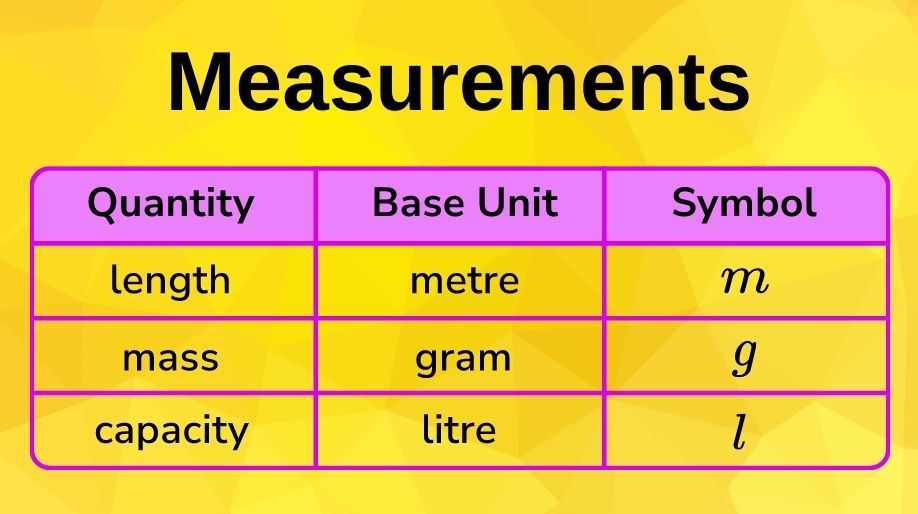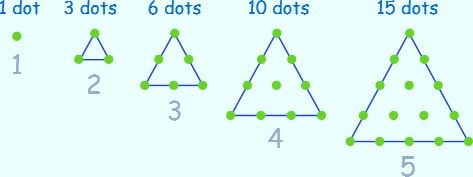- If we consider metre, litre, and gram as units of measurement, the higher units are obtained by adding the prefixes deca (meaning ten), hecto (meaning hundred) and kilo (meaning thousand).
- The lower units are obtained by adding the prefixes deci (meaning tenth), centi (meaning hundredth), milli (meaning thousandth)
|
Thousands 1000 |
Hundreds 100 |
Tens 10 |
Ones |
Tenths 1/10 |
Hundredths 1/100 |
Thousandth 1/1000 |
|
Kilo |
Hecto |
Deca |
Metre Litre Gram |
Deci |
Centi |
Milli |
Measures of length
Length is the longest extent of anything as measured from end to end.
Length
 In the above example length is
In the above example length is
used to measure how long the line is.
- 10 millimetres (mm) = 1 centimetre
- 10 centimetres (cm) = 1 decimetre
- 10 decimetres (dm) = 1 metre
- 10 metres (m) = 1 decametre
- 10 decametres (dam) = 1 hectometre
- 10 hectometres (hm) = 1 kilometre (km)
Measures of mass
Mass is the measure of amount of matter in an object.
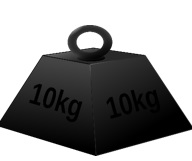
- 10 milligrams (mg) = 1 centigram
- 10 centigrams (cg) = 1 decigram
- 10 decigrams (dg) = 1 gram
- 10 grams (g) = 1 decagram
- 10 decagrams (dag) = 1 hectogram
- 10 hectograms (hg) = 1 kilogram (kg)
Trivia Question:
How many centimetres in a mile?
Measures of capacity
Capacity is the amount a container can hold
- 10 millilitres (ml) = 1 centilitre
- 10 centilitres (cl) = 1 decilitre
- 10 decilitres (dl) = 1 litre
- 10 litres (l) = 1 decalitre
- 10 decalitres (dal) = 1 hectolitre
- 10 hectolitres (hl) = 1 kilolitre (kl)
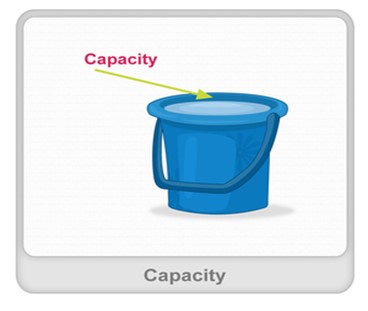
Measures of volume
Volume is the measure of the space taken up by something.
- 1000 cubic millimetres (mm3) = 1 cubic centimetre
- 1000 cubic centimetres (cm3) = 1 cubic decimetre
- 1000 cubic decimetres (dm3) = 1 cubic metre
- 1000 cubic metres (m3) = 1 cubic decametre
- 1000 cubic decametres (dam3) = 1 cubic hectometre
- 1000 cubic hectometres (hm3) = 1 cubic kilometre (km3)


EXAMPLE 1: Express 1357.912 metres in higher units and lower units.
SOLUTION:
|
Kilometre |
Hectometre |
Decametre |
Metre |
Decimetre |
Centimetre |
Millimetre |
|
1 |
3 |
5 |
7 |
9 |
1 |
2 |
1357.912 metre
=135.7912 decametres
=13.57912 hectometres
=1.357912 kilometres
=13579.12 decimetres
=135791.2 centimetres
=1357912 millimetres

EXAMPLE 2: Express 2 g 3 dg 4cg 5mg in terms of milligrams.
SOLUTION:
2g = 2000mg
3dg= 300mg
4cg= 40mg
2g 3dg 4cd 5mg = (2000 + 300 + 40 + 5) mg =2345mg [Ans]
EXAMPLE 3: Express 1m3 6dm3 7cm3 8mm3 in terms of mm3.

Measurements: Addition
- Add the numbers in each position, if a carry is generated then add the carry with the digits in the next position.
EXAMPLE 1: Add 2l 3dl 4cl 5ml & 6l 6dl 7cl 8ml
SOLUTION:
2l 3dl 4cl 5ml + 6l 6dl 7cl 8ml 9l 0dl 2cl 3ml [Ans]
EXAMPLE 2: Express the above result in terms of ml.
SOLUTION:
2345ml + 6678ml 9023ml

- Subtract the number in each position, if a borrow is taken then add it to the next position where subtraction will take place.
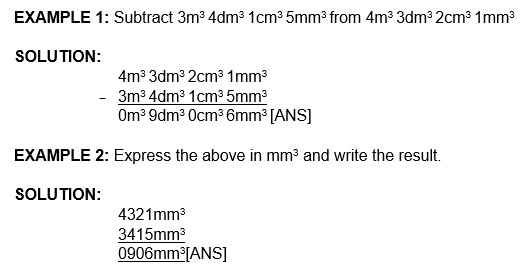
Measurements: Multiplication and Division
- When a quantity is multiplied by a number, we are actually adding the same quantity a repeated number of times.
For example,
When 15kg is multiplied
by 3, we are actually adding
the amount 15kg three times.
- When a quantity is divided by a number, we are actually splitting the quantity.
For example,
6 litres of oil is
to be divided into
3 separate containers.
Here, we are dividing 6 by 3.
which is equal to 2. Thus, each
container would contain 2 litres of oil.
- Two different quantities can be multiplied or divided. When we do so, we get a new quantity.
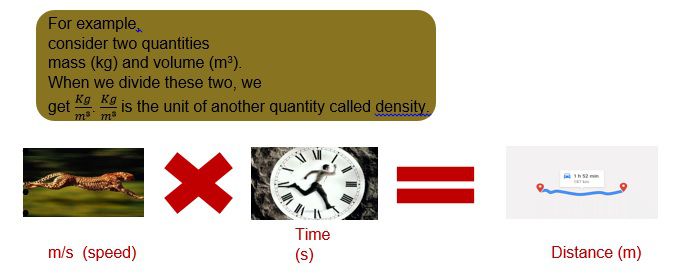
EXAMPLE 1: Multiply 123g by 23.
SOLUTION:
1 2 3 g
X2 3_
369
+2460
2829 g [ANS]

Temperature
- Temperatureis the measure of the hotness or coldness of a substance. A thermometer is an instrument which is used to measure temperature.
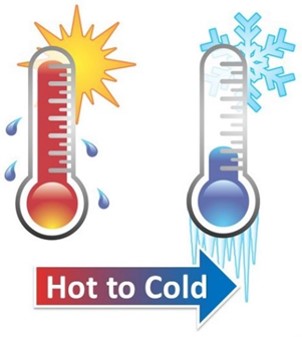
- Temperature is measured in three scales: Celsius, Fahrenheit, and Kelvin.
|
From |
To Fahrenheit |
To Celsius |
|
Fahrenheit (F) |
F |
(F - 32) X 5/9 |
|
Celsius (C) |
(CX9/5) + 32 |
C |
|
Kelvin (K) |
(K-273.15) X 9/5 +32 |
K-273.15 |
- Celsius a measurementof temperature on a standard in which 0° is the temperature at which water freezes, and 100° the temperature at which it boils.
Celsius scale is also
known as centigrade scale.
Fahrenheit Scale- A temperature scale on which water freezes at 32 degrees Fahrenheit and boils at 212 degrees Fahrenheit.

Kelvin Scale: A temperature scale that defines absolute zero as 0 degrees. Water freezes at 273 degrees and boils at 373 degrees at this temperature.
All objects emit thermal energy or heat unless they have a temperature of absolute zero.
EXAMPLE 1: Convert 123 degrees Fahrenheit into Celsius and Kelvin.
SOLUTION:
Celsius= (F-32) X 5/9 = (123-32) X 5/9 =50.55 degree Celsius Kelvin= Celsius + 273 = 50.55 + 273 = 323.55 K
EXAMPLE 2: Convert 45 Celsius into Fahrenheit and kelvin.
SOLUTION:
Fahrenheit= (CelsiusX9/5) + 32 = (45X9/5) + 32 =113 degrees Fahrenheit Kelvin=Celsius + Fahrenheit = 45+273 = 318 K
Practice these questions
Q1) A bus travels 123km 45m in 6 hours. Give in km the distance travelled by the bus in 1 hour.
Q2) 7m 89cm of cloth is required to stitch 1 dress. Find the length of cloth needed in metres to stitch 23 dresses.
Q3) There was 4L 56mL of coffee in a pot. It was distributed among 7 people, each getting 89ml of coffee. While distributing, 1201ml of coffee fell on the floor. How much coffee is left in the pot?
Q4) 123kg=_____hg=_____ dag =_____g
Q5) Find the total boundary of the box given below:
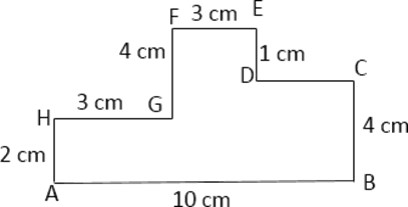
Q6) Convert 67 K into Fahrenheit and Celsius.
Recap
- Two quantities can be multiplied or divided but cannot be added or subtracted.
- Length is the longest extent of anything.
- Mass is the measure of amount of matter.
- Capacity & Volume are different.
- Temperature measures how hot or cold a substance is.
- A thermometer is used to measure temperature.
- Temperature can be measured in three scales: Fahrenheit, Celsius, and Kelvin.

